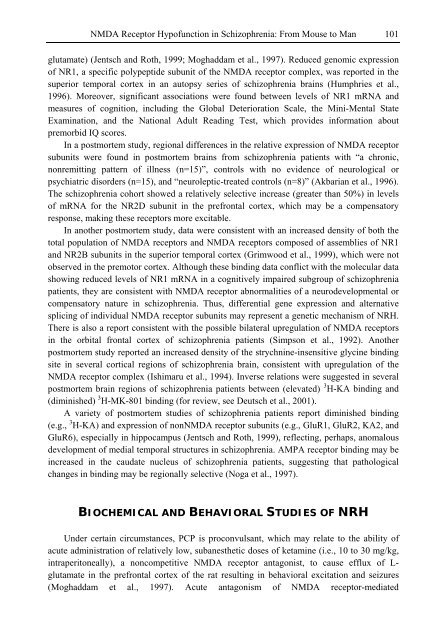Schizophrenia Research Trends
Schizophrenia Research Trends
Schizophrenia Research Trends
- No tags were found...
You also want an ePaper? Increase the reach of your titles
YUMPU automatically turns print PDFs into web optimized ePapers that Google loves.
NMDA Receptor Hypofunction in <strong>Schizophrenia</strong>: From Mouse to Man 101glutamate) (Jentsch and Roth, 1999; Moghaddam et al., 1997). Reduced genomic expressionof NR1, a specific polypeptide subunit of the NMDA receptor complex, was reported in thesuperior temporal cortex in an autopsy series of schizophrenia brains (Humphries et al.,1996). Moreover, significant associations were found between levels of NR1 mRNA andmeasures of cognition, including the Global Deterioration Scale, the Mini-Mental StateExamination, and the National Adult Reading Test, which provides information aboutpremorbid IQ scores.In a postmortem study, regional differences in the relative expression of NMDA receptorsubunits were found in postmortem brains from schizophrenia patients with “a chronic,nonremitting pattern of illness (n=15)”, controls with no evidence of neurological orpsychiatric disorders (n=15), and “neuroleptic-treated controls (n=8)” (Akbarian et al., 1996).The schizophrenia cohort showed a relatively selective increase (greater than 50%) in levelsof mRNA for the NR2D subunit in the prefrontal cortex, which may be a compensatoryresponse, making these receptors more excitable.In another postmortem study, data were consistent with an increased density of both thetotal population of NMDA receptors and NMDA receptors composed of assemblies of NR1and NR2B subunits in the superior temporal cortex (Grimwood et al., 1999), which were notobserved in the premotor cortex. Although these binding data conflict with the molecular datashowing reduced levels of NR1 mRNA in a cognitively impaired subgroup of schizophreniapatients, they are consistent with NMDA receptor abnormalities of a neurodevelopmental orcompensatory nature in schizophrenia. Thus, differential gene expression and alternativesplicing of individual NMDA receptor subunits may represent a genetic mechanism of NRH.There is also a report consistent with the possible bilateral upregulation of NMDA receptorsin the orbital frontal cortex of schizophrenia patients (Simpson et al., 1992). Anotherpostmortem study reported an increased density of the strychnine-insensitive glycine bindingsite in several cortical regions of schizophrenia brain, consistent with upregulation of theNMDA receptor complex (Ishimaru et al., 1994). Inverse relations were suggested in severalpostmortem brain regions of schizophrenia patients between (elevated) 3 H-KA binding and(diminished) 3 H-MK-801 binding (for review, see Deutsch et al., 2001).A variety of postmortem studies of schizophrenia patients report diminished binding(e.g., 3 H-KA) and expression of nonNMDA receptor subunits (e.g., GluR1, GluR2, KA2, andGluR6), especially in hippocampus (Jentsch and Roth, 1999), reflecting, perhaps, anomalousdevelopment of medial temporal structures in schizophrenia. AMPA receptor binding may beincreased in the caudate nucleus of schizophrenia patients, suggesting that pathologicalchanges in binding may be regionally selective (Noga et al., 1997).BIOCHEMICAL AND BEHAVIORAL STUDIES OF NRHUnder certain circumstances, PCP is proconvulsant, which may relate to the ability ofacute administration of relatively low, subanesthetic doses of ketamine (i.e., 10 to 30 mg/kg,intraperitoneally), a noncompetitive NMDA receptor antagonist, to cause efflux of L-glutamate in the prefrontal cortex of the rat resulting in behavioral excitation and seizures(Moghaddam et al., 1997). Acute antagonism of NMDA receptor-mediated
















